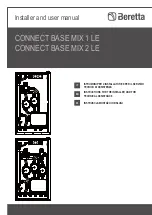
Trinity Lx
│
Installation and Operation Instructions
Lx Series
48
Indirect Fired Water Heater
– When installed as per Figure 10-3, the indirect fired water heater is in series
with the boiler during a demand for DHW. Therefore when using this configuration it is important to use an
Indirect Fired Water Heater that has minimal head loss. Indirect fired water heater head loss must not exceed
those specified in Table 10-5, when installed as per Figure 10-3.
Table 10-5
Maximum Indirect Fired Water Heater Head Loss (Boiler Side) at Minimum Flow
Lx150
10’ at 6 GPM
Lx500
18’ at 20 GPM
Lx150E
14’ at 6 GPM
Lx600
18’ at 24 GPM
Lx200
14’ at 8 GPM
Lx700
15’ at 28 GPM
Lx300
12’ at 11 GPM
Lx800
12’ at 32 GPM
Lx400
9’ at 16 GPM
Figure 10-2: Single System Circulator Configuration
- Often used in applications zoned with “Zone Valves”.
During a demand for central heat, the boiler energizes the System Circulator via the Central Heating (CH)
pump output (PUMP C). The System Circulator must be sized to provide adequate circulation throughout the
heating system. During a Domestic Hot Water (DHW) demand, the boiler de-energizes the System
Circulator (PUMP C) and energizes the DHW Circulator (Pump A). With this configuration the Boiler
Circulator is the only pump that causes flow through the boiler and it is powered during any demand via the
boiler pump output (PUMP B). This circulator must be sized according to Table 10-4.
The piping configuration described above requires the Central Heating system and DHW
system to be de-coupled from the “Primary Loop” via closely spaced tees (Figure 10-3).
Figure 10-3: Multiple System Circulator Configuration -
Often used in applications with “Zone Circulators”.
This configuration requires the installation of a check valve located at each circulator. During a central
heating demand the boiler energizes the Central Heat Circulator via the Central Heat pump out (PUMP C).
During a Domestic Hot Water (DHW) demand, the boiler de-energizes PUMP C and energizes the DHW
Circulator (Pump A). Both Pump A and C, used in this configuration, are responsible for water flow through
the boiler and must be sized according to Table 10-4. Pump output, PUMP B is not used in this
configuration.
Figures 10-2 and 10-3 illustrate typical piping systems. These piping schematics do not
illustrate all of the required concepts and components required to have a proper
installation. Concepts not shown include: prevention of thermal-siphoning (heat traps),
isolation valves, drain and purge valves, etc. It is the responsibility of the installing
contractor and system designer to determine which system best meets the need of the
installation and to consider all aspects of a proper system design. Contractor
modifications to these instructions may be required, based upon existing piping and
system design.
Содержание Trinity Lx 150
Страница 61: ...Lx Series Installation and Operation Instructions Trinity Lx 61 Figure 13 1 b Ladder Logic Diagram Lx150 400...
Страница 62: ...Trinity Lx Installation and Operation Instructions Lx Series 62 Figure 13 2 a Connection Diagram Lx500 800...
Страница 63: ...Lx Series Installation and Operation Instructions Trinity Lx 63 Figure 13 2 b Ladder Logic Diagram Lx500 800...
Страница 103: ...Lx Series Installation and Operation Instructions Trinity Lx 103 NOTES...
















































